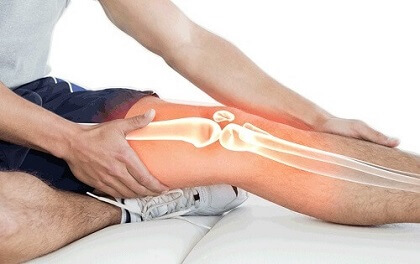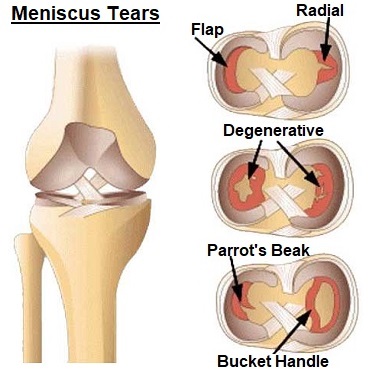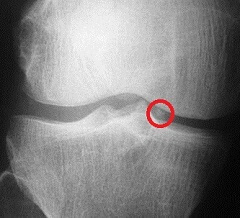- Home
- Knee Symptoms
- Knee Locking
Knee Locking
Written By: Chloe Wilson, BSc(Hons) Physiotherapy
Reviewed by: KPE Medical Review Board

Knee locking is when the leg gets stuck in one position, making it impossible to bend or straighten the knee.
A locked knee may only last a few seconds, it may last longer. It all depends on what is causing it.
There are two different types of locked knees:
- True Knee Locking: True locking at the knee is where the knee gets physically stuck and you physically can't move the knee for a period of time. True knee locking is caused by a mechanical block where something gets caught inside the joint, preventing movement.
A truly locked knee is fairly rare and typically occurs as you move the knee into full extension, i.e. towards being fully straight. - Pseudo Knee Locking: Pseudo knee locking is much more common than true locking. Here, knee movement is limited by temporary by muscle spasming as the body tries to protect itself in response to pain.
Here, we will look at the common causes of both types of knee locking up and then go on to look at the best locked knee treatment options, including how to unlock a locked knee!
What Causes True Knee Locking?
True knee locking is caused by something getting stuck inside the joint that physically prevents the knee from moving.
The knee joint is designed to bend up and down, flexion and extension, and rotate slightly. If something gets caught inside the knee joint, it blocks the movement and the leg gets stuck - think of it like a door stop. When this happens, the knee is totally blocked, unable to move at all.
It often takes a few minutes of gently moving the knee, or as patients often say “waggling it about”, to unlock a locked knee but sometimes professional intervention is needed to get the fragment to move out of the way, before you can move the leg again.
True knee locking is usually caused by:
1. Meniscus Tear
A meniscus tear is, by far, the most common cause of the knee locking up.

The meniscus is a thick piece of cartilage which lines the knee joint to provide cushioning and allow smooth movement.
If the cartilage gets torn, usually from twisting awkwardly or from gradual wear and tear, the loose fragment may get stuck in the joint stopping it from being able to move.
As the knee moves around, if the cartilage flap is large enough, it can get wedged in the wrong position, blocking the joint and causing knee locking. Your knee just won't be able to move until you are able to manoeuvre the flap out of the way, freeing up the joint.
The most common type of meniscus tear that causes knee locking is known as a bucket-handle tear. This is where part of the cartilage gets torn, but remains partially attached producing a movable flap, usually "C" shaped.
If you find your knee locking up and popping, it is most likely due to a meniscus tear.
You can find out more about the causes, symptoms and best treatment options in the meniscus tear section.
2. Loose Body
Another thing that can block the joint and cause true knee locking is when a small fragment of bone breaks off from the knee joint, known as a loose body, and floats around.
As with a meniscus tear, if it moves into the wrong place, it can get wedged in place and cause the joint to lock in a specific position.
True knee locking from a loose body may be caused by:
- Knee Injuries: Usually from a fall or awkward twisting e.g. patella fracture
- Knee Arthritis: fragments of damaged bone or cartilage breaking off. Most common cause of knee locking in the over-60's
- Bone Spurs: where an outgrowth of bone breaks off
- Osteochondritis Dissecans: Reduced blood supply to the bone causes fragments to break off. Most commonly causes knee locking in teenagers.
True knee locking may or may not be accompanied by pain, depending on the cause. It is usually extension that is limited in true knee locking, preventing you from being able to fully extend your leg.
Causes of Pseudo Locked Knee

Pseudo knee locking is almost always linked with pain. If knee pain is severe enough, then the body’s protective mechanisms kick in, limiting the movement as the body tries to prevent any damage being done. It usually does this by causing the muscles to spasm, holding the leg in position.
The difference from true locking is that there is nothing actually stuck inside the joint, and whilst the knee may at first appear to be stuck, it usually unlocks quickly. There is often more of a “catching” sensation which inhibits movement but quickly disappears rather than the knee locking up completely.
Pseudo locking can limit both flexion and extension, bending and straightening the knee, whereas true locking is usually a block to extension only.
The most common causes of pseudo locking at the knee include:
- Swelling: Excess fluid in the joint capsule, usually following an injury can limit the movement due to increased tension, preventing full flexion and extension. With correct treatment, the knee usually stops locking up once the swelling subsides
- Inflammation: inflammation of the structures in and around the knee can also limit movement. The most common causes of this are rheumatoid arthritis and gout
- Patellar Maltracking: a problem with the movement of the kneecap in the groove on the front of the knee can cause pseudo locking. It is usually very painful
- Plica Syndrome: Irritation of the medial plica, a fold in the synovial tissue lining the joint can cause pseudo locking and knee pain
- Knee Injury: Damage to any of the structures in the knee that is bad enough to elicit severe pain can induce muscle spasm which may feel like a locked knee e.g. ligament sprain
Knee Locking Treatment

Appropriate knee locking treatment will depend on whether there is something getting stuck in the joint or not. Assessment by your doctor or physical therapist should be able identify what is causing the restricted movement.
Treatment for locked knees may include:
- Knee Exercises: to improve knee strength & flexibility
- PRICE: to aid healing and prevent further damage
- Corticosteroid Injections: to reduce knee pain and inflammation
- Arthroscopic Knee Surgery: to remove any fragments of cartilage and bone that are getting stuck in the knee joint
Check out the Locked Knee Treatment section to find out loads more on how to treat and prevent knee locking as well as How To Unlock A Locked Knee.
Locked Knee Summary
Knee locking is where the knee gets stuck and can't move properly
True knee locking is caused by something getting stuck in the knee joint e.g. torn cartilage or fragment of knee bone spur
Pseudo knee locking is a protective mechanism usually caused by pain, swelling and/or muscle spasm
True knee locking may or may not be painful, whereas pseudo knee locking is usually always painful
Knee extension is limited with a truly locked knee whereas both flexion and extension are limited with pseudolocking
Locked knee treatment may involve exercises, knee injections and, in some cases, surgery.
You may also be interested in the following articles:
- Improve Knee Flexibility
- Sharp Knee Pain
- Knee Pain & Popping
- Knee Pain At Night
- Front Knee Pain
- Pain Behind The Knee
- Swollen Knee Treatment
- Top Tips On Doing Stairs With Knee Pain
Related Articles
References
1. The Journal of Pediatrics: Locked Knee in a 15-Year-Old Girl: The Knee Examination. June 2017
2. Healthline: Why Is My Knee Locking? April 2018
3. British Medical Journal Case Reports: Locked bucket-handle tears of both medial and lateral menisci with simultaneous anterior cruciate and medial collateral ligaments injury. June 2011
Page Last Updated: September 26th, 2024
Next Review Due: September 26th, 2026






